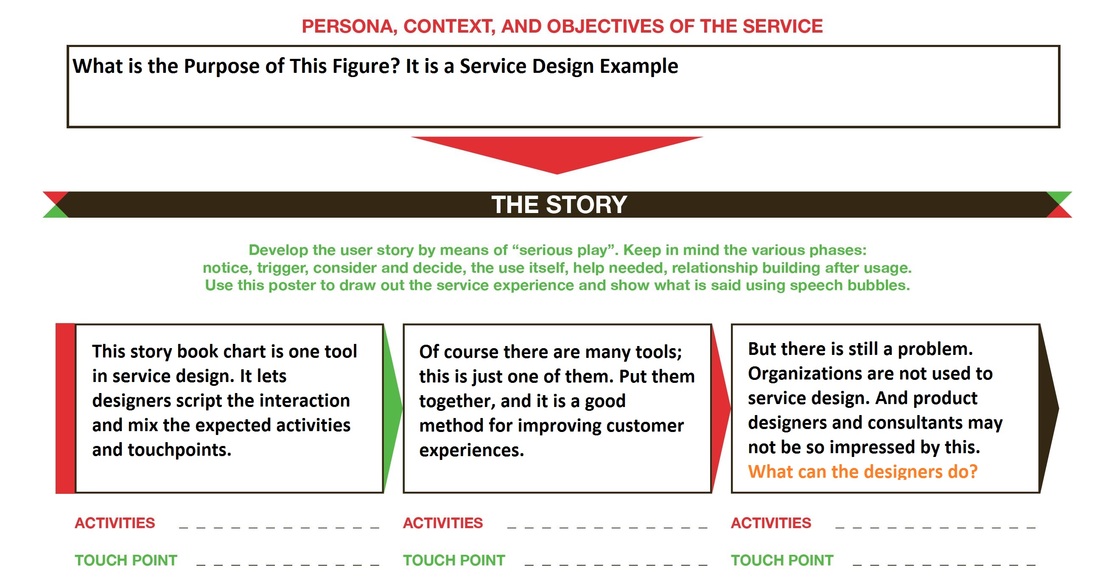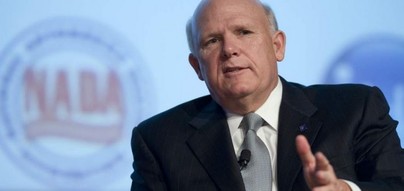 The figure above illustrates well the problem that service designers face. They are a new occupation and seek a role in designing how organizations interact with their customers or clientele, both for firms and public organizations. Such interactions have either been ignored before, or done by other occupations – for example, as part of consulting contracts. Given how important service is in the modern economy, it seems reasonable to design services – just think back to the last time (earlier today?) that bad service annoyed you or created a problem. Probably the first thing that comes to your mind is a minor annoyance, but keep in mind that hospitals and airlines are also service providers, and both of them need to avoid mistakes. Service design is useful, but new occupations always have to establish themselves as distinct and necessary. How is that done? A forthcoming paper by Anne-Laure Fayard, Ileana Stigliani, and Beth Bechky in Administrative Science Quarterly explains how the service designers found their place. They focus on the tools they used to gain a mandate as an occupation that has a distinct role in the organization, with clear authority over some tasks. Clearly the methods they developed – like the figure above – was an important part, because any methodology not held by another occupation creates distinctiveness. The closest competitors were management consultants and product designers, and none of them used such scripting tools. Service designers also developed other tools for interacting with customers and understanding their needs well. Tools were not the most important part of their mandate, however, as they saw it. Instead, they emphasized the special ethos of service designers. They had values of wholistic views of customers interactions, emphathy with the customer, and co-creation of services with customers and client firms. This ethos was more important than the tools, because the tools were just ways of putting this ethos into practice. This is an important claim because it means that one cannot become a service designer simply by copying the tools (as consultants might try), because the tools don’t work the right way when used by someone lacking the service designer ethos. Other people than service designers might believe that they can do the same work, but it would be difficult for them to provide service design legitimately wihtout a clear service designer background and signs of this ethos in how they work. The paper provides more detail, and tells an interesting story of how an occupation created itself out of nothing and made what looks like a clear mandate and a well-defended position for itself. Service design is here to stay. So, next time you experience service problems, you can ask yourself if service design has not been done, or whether it has been done poorly. Fayard, A.-L., Stigliani, I., & Bechky, B. A. 2016. How Nascent Occupations Construct a Mandate: The Case of Service Designers’ Ethos. Administrative Science Quarterly.  Interdisciplinary research is seen as very valuable for society and economy. Some of that could be hype, but there are some good examples of what it can do. You have probably noticed that oil is no longer 100 dollar per gallon, and the US is no longer a big importer. This is a result of fracking, a result of interdisciplinary research. And if you don’t like fracking, a good alternative is photovoltaic energy, which comes from the sun, and from interdisciplinary research. So some interdisciplinary research has been good for society. Is it also good for the scientists who are supposed to do it? The answer to this question is very interesting, and is reported in an article in Administrative Science Quarterly by Erin Leahey, Christine Beckman, and Taryn Stanko. The start is easy to explain: interdisciplinary research is less productive, but it gets more attention. The answer got more complicated, and more interesting, when they started looking at why that happened. The first step was to look at whether interdisciplinary research is more difficult to do, or whether it is because it is harder for it to gain acceptance and get published. The answer is clear: it is not harder to gain acceptance, but it is harder to do, especially early on. The second step was to look at why this research got more attention. Here many factors played a role, but one stood out to me: Actually what increases especially much is the variation in how much attention interdisciplinary research gets, and that helps explain the increased average. So interdisciplinary research is related to fracking in one more way – few reap the awards from it. This paper doesn’t really result in career advice for scientists, because everyone will be interested in different kinds of research, and have different ideas on how much risk to take on. But has important insights on how innovations are made. Building on closely related ideas is much easier to do, so no wonder much of what scientists – and companies – do is incremental. And this is true even though we often tell stories of the great successes of interdisciplinary research and integrative innovations, while forgetting all those who tried and didn’t succeed. Whether that means we cross-fertilize knowledge too little, too much, or just enough is hard to tell. Leahey, E., Beckman, C. M., & Stanko, T. L. 2016. Prominent but Less Productive: The Impact of Interdisciplinarity on Scientists’ Research. Administrative Science Quarterly.  Let’s start with religion. Ragnarok is a series of disasters on earth, ending with the great battle of the Norse Gods against Giants and beasts. For those who don’t read sagas (or play the computer game Ragnarok), the Norse Gods are very diverse, which helps them defeat their enemies. So, do things also work that way in our world? A recent paper in Administrative Science Quarterly by Sunasir Dutta tells us that the answer is yes and no. Let me explain. He examines the effect of natural disasters on communities in California, which of course is one of the few states with enough disasters to do such a study. He is interested in whether the communities can found new human services organizations to help disaster recovery. The answer is that communities with more diversity of voluntary associations are better able to recover from disasters, and this effect is bigger for more unexpected disasters and more complex disasters. An unexpected disaster would mean something that the community does not expect, like a flood in the Southern California counties that often get hit by wildfires instead. A complex disaster is when multiple events happen in the same year, like an earthquake and a wildfire (I am not making this up – it happens). So part of the answer is yes, and it is a good illustration of how communities build organizing capacity that can help them later on. But the answer is also no. Political diversity makes a community less capable of founding new human services organizations to help disaster recovery, possibly because it is related to disagreement and polarization that complicates the unified effort needed to form human services organizations. This is an interesting contrast because it illustrates how diversity can have many different effects. Voluntary organizations provide a community with models of organizing, trained volunteers, and networks of people who help each other. They are a form of organizing capacity that gets stronger the more kinds are present. I have written more about this in a blog post on research community imprinting. On the other hand, political views are markers of ideological boundaries. They also represent different views of who are responsible for community help, how it should be organized, and how it should be led. No wonder these forms of diversity have opposite effects. Dutta, S. 2016. Creating in the crucibles of nature's fury: Associational diversity and local social entrepreneurship after natural disasters in California, 1991-2010. Administrative Science Quarterly, forthcoming.  Facebook is the quintessential small company with high value that are becoming more common in the modern economy. How small is small? As of December 2015, they employ 12,000. What about Google? 57,000 employees. And if turn to the other side of the modern economy, services, we find that Walgreen has 240,000 employees – I am deliberately not showing Walgreen instead of Walmart because we all know that Walmart is a giant firm. And taking the step back into industry, Ford Motors has 199,000 employees (again I am not picking the largest, which would be GM). When these firms do well – or poorly – who do we credit or blame? The answer is surprisingly political. In a recent study of executive compensation published in Administrative Science Quarterly, Abhinav Gupta and Adam Wowak examine whether the different views of leadership held by Republicans and Democrats affect how Chief Executive Officers get paid. The idea is simple – members of the board of directors determine how much the CEO gets paid, and they reveal their political views through donations to the parties (naturally they can donate to none, one, or both). If the board members believe that CEOS are largely responsible for what ten to hundred thousand people do, they will pay the CEOs more on average, and they will also make the pay more sharply dependent on the recent performance. It is not a secret that Democrats attribute a lot of credit to the collective effort of workers and managers, and less to the CEO. What has become clear recently is that there is a clear authoritative streak in the Republican Party, and accordingly a tendency to credit the results to the CEO. Do the results of the study bear this out? Abundantly. A Republican dominance of a board leads to higher CEO pay. It also leads to more dependence of the CEO compensation on accounting profit and stock market value increase. Even more revealing: these relations are stronger when the analysis is limited to the compensation committee, which is the subgroup of the board that determines CEO pay (usually with the help of consultants). So now we know that CEO pay is political, in additional to the earlier findings showing that it is customary and performance dependent. Does that make CEO pay unfair? Well, actually the answer to that is political too. Consider how you feel about this issue; it probably fits your political views in general. Gupta, A., & Wowak, A. J. 2016. The Elephant (or Donkey) in the Boardroom: How Board Political Ideology Affects CEO Pay. Administrative Science Quarterly, forthcoming. |
Blog's objectiveThis blog is devoted to discussions of how events in the news illustrate organizational research and can be explained by organizational theory. It is only updated when I have time to spare. Archives
May 2024
Categories |
 RSS Feed
RSS Feed